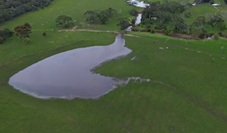It’s easy not to fully appreciate the geography of a place, even one you’ve visited for over 40 years.
Of course, having crossed the bridge over the Painkalac Creek between Airey’s Inlet and Fairhaven hundreds of times, I had seen the transformation of the inlet and estuary from a degraded, treeless landscape to the wonderful wetland area it is today. That transformation is due to the commitment and hard work of many members of Angair and the community over a long period. What I hadn’t really noticed was how, hidden from view when crossing the bridge, there was also an upper part of the Painkalac Valley, a flood plain skirted by Bambra Rd running from the bottom of the Aireys Inlet hill to the meandering edge of the Painkalac Creek.
This flood plain, despite having been cleared over a hundred years ago, still contains a series of remnant water features: ephemeral lakes, billabongs, watercourses and small tributaries to the main creek despite the limiting effect of the Painkalac Dam upstream. Around the world it is these wetland habitats, so important for birds, animals and plants, that are most under threat from human activity. The Painkalac Creek is such an important environment that it has recently been listed by the Federal Environment Minister as one of 25 ‘salt wedge’ sites around the Australia coast worthy of special protection.
Having seen the success with rehabilitating the lower valley, my wife Jacinta and I bought an area of approximately 11 acres in the upper valley on Bambra Rd near Old Coach Road. We were particularly interested in this site as it included a large, drained series of billabongs which could be seen in old aerial photographs.
 Billabong
Billabong
The billabongs were drained and back filled several decades ago. We aimed to revegetate the block and reinstate the billabongs and ephemeral lake that still frequently form over winter and spring as seen in the drone photo, left taken after heavy rain in September 2017. The wetlands will provide not only habitat for birds and native animals but also improve the water quality of the creek.
Angair has enthusiastically supported this project and successfully applied for a Victorian Landcare Grant to facilitate the rehabilitation of the block. Working bees have already started with up to 30 enthusiastic volunteers involved.

The aim is to plant local indigenous species, extending the natural vegetation on the eastern side of Bambra Road down to the Painkalac Creek, providing a natural corridor between the two. Almost 1500 plants are already in the ground as seen in the photos above and below.

Other work on the land has started with the removal of some fencing and extensive weeding. The billabongs and lake now contain much birdlife and the kangaroos are plentiful. Working bees are planned for the third Sunday each month but may be changed due to other commitments. Dates will be advertised in the Angair newsletter. If you would like to be involved, please contact Roger Ganly on 0409502480 or email at rganly8@bigpond.com
Mick Loughnan